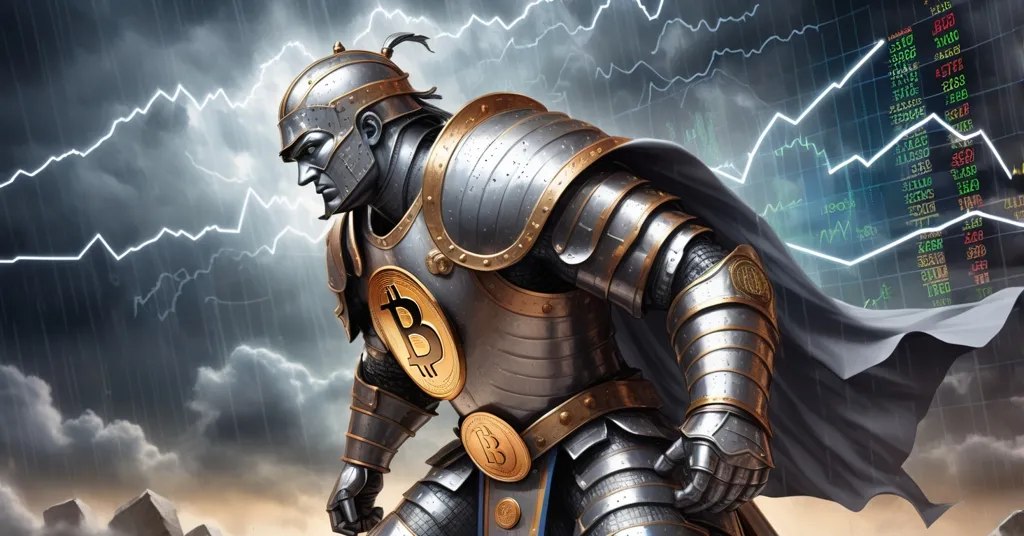Bitcoin Struggles at $110K: Market Correlation and Macro Pressures Stall Rally

Bitcoin Stalls at $110K Resistance: Macro Headwinds and Market Correlation Weigh Heavy
Bitcoin (BTC) has notched a 3.5% gain between June 7 and June 9, climbing to $108,500, but it’s slamming into a stubborn wall at $110,000. With economic storm clouds gathering and Bitcoin mimicking stock market moves, we’re unpacking the hard data, trader sentiment, and global financial pressures to figure out why the king of crypto can’t punch through—and whether a breakout or breakdown looms on the horizon.
- Bitcoin’s 3.5% rise to $108,500 hits resistance at $110K amid recession fears and an 82% correlation with the S&P 500.
- Derivatives data reveals cautious trader sentiment, with neutral futures premiums signaling no speculative bubble.
- A rally to $150K could ignite if trust in US fiscal stability crumbles, though short-term risks like economic downturns threaten progress.
Bitcoin Price Analysis: So Close, Yet So Stuck
Bitcoin is teasing us, sitting just 3% shy of its all-time high of $111,965 set on May 22. That’s a testament to its grit, but the absence of bullish steam is glaring. Data from Laevitas.ch shows Bitcoin futures premiums hovering at a neutral 5% since June 6—a far cry from the double-digit spikes of past bull cycles. For the uninitiated, futures premiums measure the extra cost of buying Bitcoin futures over its spot price; think of it like betting odds on a big game—high premiums mean traders are all-in on a win, while low ones signal they’re hedging their bets. Right now, pros aren’t piling on leverage, which is actually a relief. No frothy, over-leveraged hype means this uptick isn’t a house of cards. But let’s not kid ourselves: this flat sentiment reeks of indecision.
What’s truly holding Bitcoin down is its uncomfortably tight dance with the S&P 500, showing an 82% correlation over the past four weeks according to TradingView data. Correlation, in simple terms, tracks whether two assets move in sync—100% means they’re joined at the hip, 0% means no connection. At 82%, Bitcoin is less “digital gold” and more “tech stock with extra volatility.” For anyone holding BTC as a hedge against traditional markets, this is a bitter pill—when Wall Street stumbles, Bitcoin trips too. This pattern isn’t brand new; it’s fluctuated over the last nine months, but currently, it’s a heavy drag. If whispers of a US recession grow louder, expect Bitcoin to feel the burn alongside equities.
Macroeconomic Pressures: A Ticking Time Bomb for Risk Assets
US Fiscal Risks Loom Large
Let’s zoom out to the bigger economic picture, because it’s impossible to ignore. The US is wrestling with a potential $4 trillion debt ceiling hike—basically, the legal cap on how much the government can borrow to cover its bills. Rumblings of fiscal instability are getting harder to shrug off. Bitcoin was born from the 2008 financial meltdown as a defiant middle finger to centralized, fragile systems. If faith in the US Treasury or the dollar as the world’s reserve currency starts to crack, we could see a flood of capital—potentially from the $50 trillion S&P 500 market or trillions in government bonds—shift into Bitcoin. Given BTC’s relatively small market cap, even a modest inflow could rocket prices past $150,000, as some bold analysts are speculating on platforms like Quora.
Economic Downturn Threats
But don’t get too starry-eyed. As long as the US dollar holds its iron grip as the global reserve currency, Bitcoin stays vulnerable to the same forces battering stocks. High interest rates, for instance, are a slow bleed—recent Federal Reserve hikes have tightened liquidity, meaning less cash for riskier plays like BTC, as investors flock to safer bets like bonds. Escalating trade war tensions and recession signals only pile on the pain. If a downturn solidifies, holding above $110K will be a brutal fight. OKX’s Bitcoin margin long-to-short ratio sits at 4:1, showing longs outnumber shorts but not by much. For context, ratios above 20:1 scream irrational exuberance, while below 5:1 tilt bearish. Right now, we’re in a tense holding pattern of “wait and see,” with deeper insights into these macro trends available for those digging into the data.
Regulatory Shadows: A Growing Threat to Bitcoin’s Freedom
Beyond economics, there’s another storm brewing: regulation. Governments worldwide are twitchy about crypto’s rise, especially if stablecoins or decentralized markets start nipping at the dollar’s dominance. In the US, recent moves to monitor bank transactions over a measly $600 (a grotesque overreach on privacy) hint at tighter scrutiny ahead. Proposals for crypto tax reporting rules and the EU’s MiCA framework could stifle adoption or spook investors. While Bitcoin’s decentralized, censorship-resistant nature makes it tough to fully choke, heavy-handed laws could still dampen mainstream uptake or tank market confidence overnight.
That said, Bitcoin’s core strength is its defiance. No central authority can flip a switch and kill it—unlike fiat systems or even some altcoins with centralized weak points. This resilience could shine if regulatory crackdowns backfire and drive more users underground into truly decentralized networks. Still, it’s a risk we can’t ignore in the short term.
Challenging the Narrative: Is Bitcoin Really Digital Gold?
As a Bitcoin maximalist, I bleed for decentralization, privacy, and financial sovereignty. But let’s flip the script and poke holes in our own story. The “Bitcoin as a hedge” mantra gets parroted every time the economy wobbles, yet that 82% correlation with stocks laughs in its face. Investors largely see BTC as a speculative gamble, not a lifeboat in choppy financial waters. Can you really blame them? Bitcoin’s volatility is a sucker punch—a 10% daily swing is par for the course, while gold rarely budges past 1%. During the 2020 COVID market crash, Bitcoin tanked alongside stocks before recovering, unlike gold’s steadier climb. It’s hard to call something a safe haven when it rides the same rollercoaster as Wall Street.
Yet, there’s another angle. Bitcoin has proven its worth as a hedge in extreme cases—think hyperinflating economies like Venezuela or Zimbabwe, where citizens have turned to BTC to escape currency collapse. Closer to home, a potential supply shock could flip the script. Cointelegraph points to declining Bitcoin reserves on exchanges, and Glassnode data shows a consistent drop in available BTC as whales hoard. Add in the recent $110 million Bitcoin buy by a strategic investor, and it’s clear big players are stacking, not selling. If fiat trust truly unravels, Bitcoin’s borderless, unconfiscatable design could finally shed the “risk-on” label and stand as a true alternative, as explored in detailed supply dynamics analysis.
Bitcoin’s Supply Dynamics: A Sleeping Giant?
Speaking of supply shocks, this deserves a deeper look. Exchange reserves of Bitcoin have been trending downward for months, per Glassnode analytics, meaning less BTC is readily available for trading. Post-halving dynamics—where Bitcoin’s issuance rate drops roughly every four years—further tighten the screws on supply. The 2024 halving isn’t here yet, but anticipation builds scarcity narratives. Meanwhile, whale accumulation, like the $110 million scoop, signals confidence among deep-pocketed players. If demand spikes (say, from institutional FOMO or a macro crisis), this constrained supply could act like a pressure cooker, exploding prices upward. It’s not a guarantee, but it’s a wildcard worth watching, especially with current market trends showing mixed signals.
Beyond Bitcoin: Altcoins and Blockchain Innovation Steal Some Thunder
While Bitcoin holds my loyalty and the crown as a store of value, I can’t ignore the broader blockchain space carving out its own turf. Ethereum and other protocols are grinding away at problems Bitcoin isn’t built to solve. Take zero-knowledge Ethereum Virtual Machines (zkEVMs)—they’re like privacy shields, verifying transactions without spilling sensitive data, boosting both security and efficiency. Layer 2 solutions like Polygon act as side roads for Ethereum’s congested highway, slashing infamous gas fees (those nasty costs for transactions, sometimes $50 just to move $5 worth of crypto) by processing off-chain before settling securely on the mainnet. Community discussions on platforms like Reddit highlight these innovations as game-changers.
Decentralized finance (DeFi) keeps evolving too. From early hits like Uniswap’s decentralized trading to newer ideas like protocol-owned liquidity (POL), DeFi is building financial systems without middlemen. Cross-chain bridges via projects like Cosmos let blockchains talk to each other, a step toward seamless integration. Stablecoins aim to be the on-ramp for mainstream users, though centralized ones like Tether raise red flags with shaky claims of full USD backing. Bitcoin doesn’t touch these niches—programmable money, lightning-fast micropayments, or tokenized assets like NFTs—and that’s fine. BTC is the bedrock, but altcoins and DeFi are the experimental labs. Sure, scams and rug pulls litter the space (half these projects are pure garbage), but the real innovators indirectly boost Bitcoin by onboarding more users to crypto overall, a topic debated extensively on Quora.
Take Polygon’s partnerships with major brands or Uniswap’s massive trading volume—these show real-world utility. Yet risks like smart contract bugs or overhyped “yield farms” collapsing remind us innovation cuts both ways. It’s a messy, wild west, but one that complements Bitcoin’s mission to disrupt the status quo.
The Brutal, No-Hype Reality of Bitcoin’s Outlook
Short-Term Struggles
Let’s cut through the noise. I’m beyond frustrated with self-proclaimed “gurus” on X hyping “Bitcoin to $200K by year-end!” based on nothing but doodled trendlines and fake technical analysis charts on YouTube. That’s not insight; it’s a con job preying on hopeful newbies. The hard truth is Bitcoin’s near-term upside is chained by macro headwinds and lukewarm trader sentiment. Breaking past $110K isn’t impossible, but it’ll take a seismic event—a confirmed recession, a debt ceiling blowup, or some black-swan chaos—to untangle BTC from the stock market’s web. Until then, expect a grind. Derivatives data, with futures premiums at a measly 5%, and historical context—think 2021’s 15-20% premiums during true bull mania—show no one’s betting the farm just yet.
Long-Term Vision and Effective Accelerationism
Zoom out, though, and I’m as bullish as they come. Bitcoin’s fundamentals—scarcity with a hard-capped 21 million supply, decentralization beyond any government’s full control, and immunity to manipulation—stand unbreakable. It’s the ultimate middle finger to a broken financial system. This ties into the philosophy of effective accelerationism (e/acc) we champion: push tech adoption hard and fast, even if it’s messy, to force systemic change. Bitcoin, DeFi, and blockchain at large are the battering rams against centralized power. Short-term pain—volatility, regulatory pushback—is just the cost of dismantling the old guard. Long-term, Bitcoin could anchor a new financial reality, especially if macro cracks widen and drive capital its way.
Calling Out the Scammers
One last jab: beware the shills. Price prediction hype, especially the absurd “guaranteed moonshot” nonsense flooding social media, is often a scam to pump bags or sell dubious courses. Focus on fundamentals—supply dynamics, adoption metrics, macro shifts—not some random’s sketchy chart. We’re here to drive responsible adoption, not gamble on fairy tales. If it smells like snake oil, it probably is.
Bitcoin’s a warrior in a gritty arena right now. It’s got the muscle to dominate, but macro markets keep throwing haymakers. Altcoins and DeFi are forging their own fronts, and that diversity strengthens the fight for decentralization. We’ll keep exposing the frauds while amplifying the disruptors. Economic tremors could flip this game in a heartbeat—stay sharp. Are we ready to break free from Wall Street’s shadow?
Key Questions and Takeaways on Bitcoin’s Price and Crypto Trends
- Why is Bitcoin stuck below $110K?
Bitcoin’s price is tethered by an 82% correlation with the S&P 500 and looming US recession fears, making it react like a risk-on asset rather than a standalone hedge. - What could propel Bitcoin to $150K?
A breakdown in trust in US fiscal stability or a debt ceiling crisis could divert capital from traditional markets to Bitcoin, especially with a supply shock tightening available BTC on exchanges. - Are traders bullish on Bitcoin currently?
Not strongly—futures premiums linger at a neutral 5%, and OKX’s long-to-short ratio of 4:1 shows cautious, not exuberant, sentiment among professional traders compared to past bull runs. - How do macroeconomic factors hurt Bitcoin?
High interest rates, trade war tensions, and recession risks drag Bitcoin down alongside equities, with the US dollar’s reserve status keeping BTC exposed to these pressures. - What risks do regulations pose to Bitcoin?
Government crackdowns, like US transaction monitoring or EU frameworks, could slow adoption or shake confidence, though Bitcoin’s decentralized design offers resistance to total control. - How do altcoins and DeFi complement Bitcoin?
Ethereum, Layer 2s like Polygon, and DeFi projects tackle programmable money, scalability, and tokenized assets like NFTs, filling niches Bitcoin doesn’t address while supporting broader crypto growth. - Is Bitcoin a safe haven during economic uncertainty?
Not yet in practice—its stock market correlation undercuts the “digital gold” label for now, though its fundamentals and real-world use in hyperinflating economies position it as a potential refuge.



